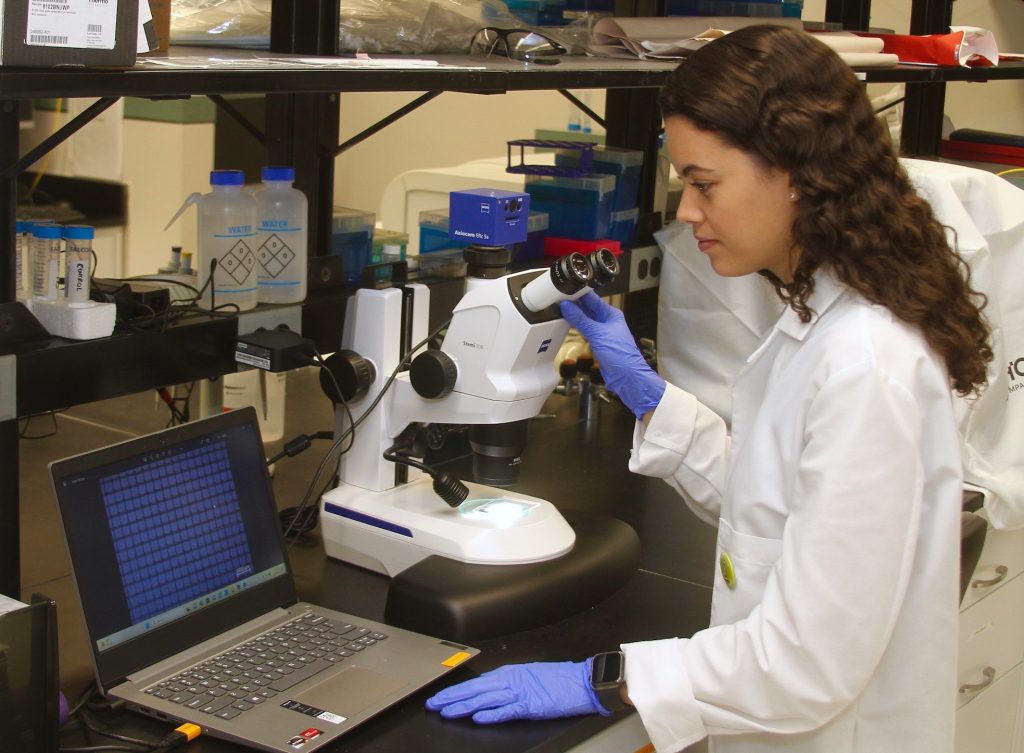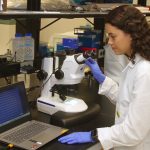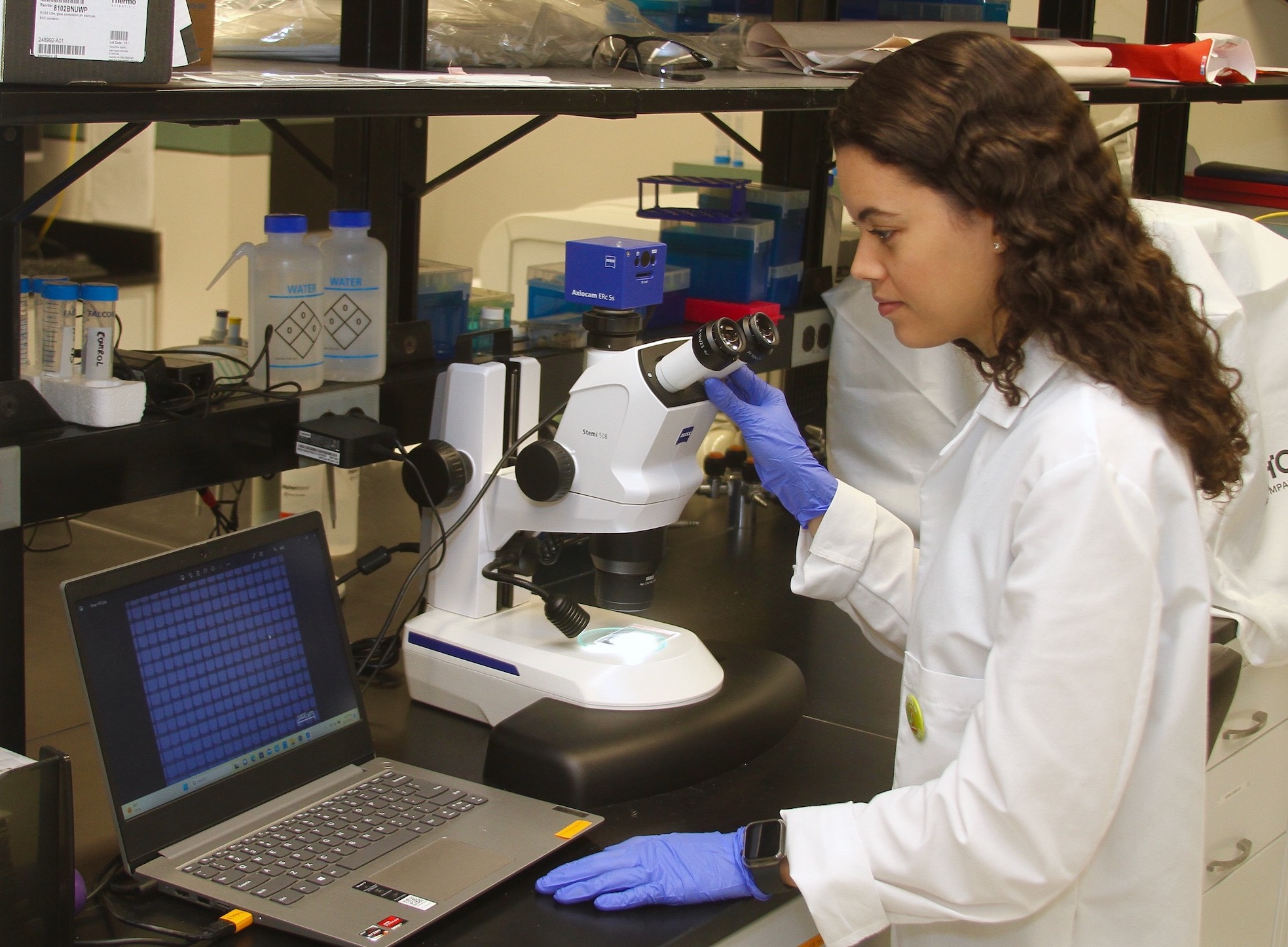School of Dentistry faculty, staff and students continued to advance scientific research with a broad array of publications in 202310 min read

Ann Arbor, Mich., Feb. 8, 2024 – The University of Michigan School of Dentistry continued its leadership in important dental, oral and craniofacial research in 2023 with faculty publishing 263 papers, articles and reviews in a variety of leading scientific journals. The school’s annual research expenditures totaled $24.9 million and faculty received 38 grants, the most in the last five years.
U-M has long been a leader among U.S. dental schools in its commitment to research as a core part of its educational mission of training dental students. Current research by faculty and their teams of research assistants ranges widely, including advances in bone and soft-tissue regeneration; how nerve density affects tumor development and progression in oral squamous cell carcinoma; anomalies in facial and skull anatomy; biological mechanisms in palatogenesis and cleft palate; and the mechanisms inhibiting regeneration of salivary glands that have been damaged by cancer radiation treatments.
Research is centered among the school’s four research themes of Cancer Biology and Therapeutics; Clinical, Population and Educational Research; Craniofacial, Skeletal Biology and Disease; and Tissue Engineering and Regenerative Medicine. They are part of the school’s mission of “Advancing health through education, service, research and discovery.”
“Our faculty, their research labs and staff, are doing truly remarkable research that promotes the integration of basic, translational, clinical and health services research,” said Vesa Kaartinen, associate dean for research. “The ultimate goal is to stimulate discoveries and translate the new knowledge into clinical practice that can improve healthcare for dental patients and other patients who require a wide variety of treatment for various diseases, genetic disorders and trauma.”
The school highlights its research during an annual Research Day, set this year for Thursday, Feb. 15. Students, postdoctoral trainees, staff and faculty members will display more than 110 posters at morning and afternoon sessions at the Michigan League. The keynote speaker, at 1 p.m. in Kellogg Auditorium at the School of Dentistry, is Dr. Rena N. D’Souza, Director of the National Institute of Dental and Craniofacial Research. A highly accomplished dentist-scientist, Dr. D’Souza is a leading researcher in craniofacial development, genetics, tooth development and regenerative dental medicine. She is also recognized as a visionary leader who has brought transformative changes to dental, oral and craniofacial research through her leadership of the NIDCR. More information on Research Day 2024 can be found here.
The following are a few examples of the top papers by faculty and research staff at the school in 2023, based on high impact journal ratings. The journal name is followed by links to the paper’s PubMed abstracts, with dental school faculty/staff noted in bold:
• Bioactive Materials: Tissue-specific melt electrowritten polymeric scaffolds for coordinated regeneration of soft and hard periodontal tissues. The limited successful outcomes of clinically available approaches to treating periodontitis emphasize the need for therapeutics that provide structural guidance to cells and can help regulate immune response to healing. In this study, three-dimensional melt electrowritten scaffolds with tissue-specific attributes were engineered to guide differentiation of human-derived periodontal ligament stem cells and mediate macrophage polarization. Scaffolds with various fiber morphology (aligned vs. random) and highly-ordered architectures with distinct strand spacings were tested. Among the findings were that stem cells grown on scaffolds with wider strand spacing showed signs of better bone development, whereas the randomly oriented scaffolds encouraged more immune response. The findings are promising for more effective treatment of periodontitis. Authors: Arwa Daghrery, Jessica Ferreira, Jinping Xu, Nasim Golafshan, Darnell Kaigler, Sarit Bhaduri, Jos Malda, Miguel Castilho, Marco Bottino.
• Cell Death and Disease: Caspase-9 driven murine model of selective cell apoptosis and efferocytosis. This study created a new model to advance research into two biological processes – apoptosis, which is a kind of programmed cell death, and the related efferocytosis, the process where dying cells are eliminated by specific “cleaner” cells. Both processes are integral to growth, development and homeostasis, but they are challenging to study because they vary across different types of cells and tissues. The researchers’ new model, named inducible caspase-9 (iCasp9), can be switched on to purposely trigger the apoptosis process in a targeted cell, helping researchers study efferocytosis, which follows. The results showed that dendritic cells (a type of “cleaner” cell) infiltrated specific areas in response to the programmed cell death. In the bone, where efferocytosis is not thoroughly researched, there was direct in vivo evidence that macrophages (another type of “cleaner” cell) play a pivotal role in cleaning up dead cells. The findings will help researchers understand the array of mechanisms and effects that come with apoptosis and efferocytosis, which are crucial to our understanding of human health and disease. Authors: Lena Batoon, Amy Koh, Rahasudhaa Kannan, Laurie McCauley, Hernan Roca.
• Elife: Control of Craniofacial Development by the Collagen Receptor, Discoidin Domain Receptor 2. People with the genetic disease spondylo-meta-epiphyseal dysplasia, or SMED, have characteristic facial and skull abnormalities including a flattened face and shortened skull. SMED is associated with mutations that inactivate the gene encoding a protein called discoidin domain receptor 2 (DDR2), which is a receptor for collagen. Collagen is the major structural protein in the human body, supporting the structure of cells and tissues. It also controls cell behaviors including growth, migration and differentiation, and it helps form tissues such as cartilage or bone. At least some of the effects of collagen on cells depend on its interaction with DDR2. Cells that normally produce DDR2 are the progenitors of cartilage and bone-forming cells, which partly explains why lacking this protein leads to issues in growth of these tissues. The study provides insights into the mechanisms controlling the formation of facial and skull bones that depend on interactions between cells and collagen. This information may help explain how other abnormalities in the face and skull emerge, and provide a basis for how the shape of the skull has changed during human evolution. In the future, it may be possible to manipulate the activity of DDR2 to correct skull defects. Authors: Fatma Mohamed, Chunxi Ge, Shawn Hallett, Alec Bancroft, Randy Cowling, Noriaki Ono, Abdul-Aziz Binrayes, Barry Greenberg, Benjamin Levi, Vesa Kaartinen, Renny Franceschi.
Microbiome: Salivary microbiome changes distinguish response to chemoradiotherapy in patients with oral cancer. Oral cancer is associated with an imbalance of the oral microbiome but it is unclear how treatment affects this imbalance. Researchers compared changes in the salivary microbiome before and after treatment in patients with oral cancer by 16S rRNA gene sequencing and examined how microbiome changes correlated with the expression of an anti-microbial protein. There were changes in the microbial communities before and after chemoradiation but not surgery. Moreover, patients who did or did not respond to chemoradiation had different levels of some types of bacteria both before and after treatment. There was a significant increase in an anti-microbial protein after treatment. This is the first longitudinal study to investigate treatment-associated changes in the oral microbiome in patients with oral cancer along with changes in expression of an anti-microbial protein in saliva. The results of this research suggest that some oral microbiota may predict treatment response in patients with oral cancer. Authors: Marcell Costa de Medeiros, Stephanie The, Emily Bellile, Nickole Russo, Ligia Schmitd, Erika Danella, Priyanka Singh, Rajat Banerjee, Christine Bassis, George Murphy, Maureen Sartor, Isabelle Lombaert, Thomas Schmidt, Avi Eisbruch, Carol Anne Murdoch-Kinch, Laura Rozek, Gregory Wolf, Gen Li, Grace Chen, Nisha D’Silva.
• Clinical Cancer Research: Increased Nerve Density Adversely Affects Outcome in Oral Cancer. Perineural invasion in oral cavity squamous cell carcinoma (OSCC) is associated with poor survival. This study evaluated whether nerve density (ND) influences tumor growth and patient survival. The study also assessed the reliability of artificial intelligence in evaluating ND. Tissue sections of OSCC from 142 patients were stained to detect nerves and tumor. ND within the tumor bulk and in the adjacent 2 mm was quantified, along with normalized nerve density (NND) for each of the various regions of the oral cavity. The study showed that tumors with high NND seem to be associated with poor survival for patients with tongue cancer, which is the most common type of oral cancer. It also showed that patients with high NND and a smaller distance between the nerve and the tumor have poorer outcomes. Reduction of nerve density by denervation in a murine model decreased tumor growth. AI and manual detection of nerves showed similar effectiveness. The study concluded that high ND enhances tumor growth, and NND is an important prognostic factor that could influence treatment selection for aggressive OSCC. Authors: Cindy Perez-Pacheco, Ligia Schmitd, Allison Furgal, Emily Bellile, Min Liu, Aya Fattah, Laura Gonzalez-Maldonado, Shelby Unsworth, Sunny Wong, Laura Rozek, Arvind Rao, Gregory Wolf, Jeremy Taylor, Keith Casper, Michelle Mierzwa, Nisha D’Silva.
• ACS Applied Materials and Interfaces:Nanoscale β-TCP-Laden GelMA/PCL Composite Membrane for Guided Bone Regeneration. Major advances in the field of periodontal tissue engineering include the fabrication of biodegradable membranes with tunable physical and biological properties for guided bone regeneration where bone is missing or damaged. Using a technique called electrospinning, researchers created a new type of tiny scaffolds with a mix of gelatin and particles of a mineral similar to bone. The holes and fibers in the scaffold supported cells that can turn into bone cells. The cells attached well, grew and made more minerals and expressed more genes related to bone formation than in previous designs. The findings advance research into new materials that are conducive to bone repair. Authors: Abdel Mahmoud, Yuanyuan Han, Renan Dal-Fabbro, Arwa Daghrery, Jinping Xu, Darnell Kaigler, Sarit Bhaduri, Jos Malda, Marco Bottino.
• Acta Biomaterials: Synthetic peptides activating discoidin domain receptor 2 and collagen‐binding integrins cooperate to stimulate osteoblast differentiation of skeletal progenitor cells.
The study’s abstract details its research into collagen interactions that are critical for bone development and regeneration. Collagen-binding integrins and discoidin domain receptors (DDR1 and DDR2) function as collagen receptors in bone. Each receptor is activated by a distinct collagen sequence; GFOGER for integrins and GVMGFO for DDRs. Specific triple helical peptides containing each of these binding domains were evaluated for the ability to stimulate DDR2 and integrin signaling and osteoblast differentiation. Researchers suggest that the development of scaffolds containing DDR and integrin-activating peptides may provide a new route for promoting bone regeneration. Authors: Chunxi Ge, Yiming Li, Fashuai Wu, Peter Ma, Renny Franceschi.
More information on the School of Dentistry’s research enterprise, its faculty and faculty labs, research training and Oral Health Sciences graduate degrees can be found on the Research Office website.
###
The University of Michigan School of Dentistry is one of the nation’s leading dental schools engaged in oral healthcare education, research, patient care and community service. General dental care clinics and specialty clinics providing advanced treatment enable the school to offer dental services and programs to patients throughout Michigan. Classroom and clinic instruction prepare future dentists, dental specialists and dental hygienists for practice in private offices, hospitals, academia and public agencies. Research seeks to discover and apply new knowledge that can help patients worldwide. For more information about the School of Dentistry, visit us on the Web at: www.dent.umich.edu. Contact: Lynn Monson, associate director of communications, at [email protected], or (734) 615-1971.


